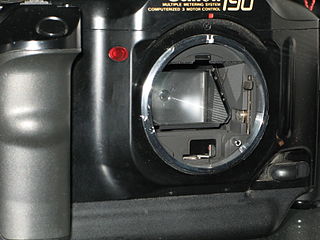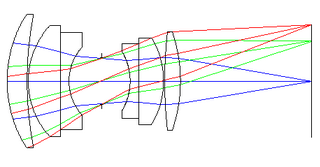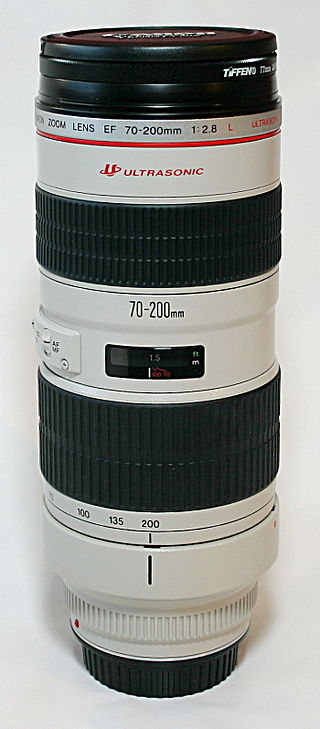
A camera lens is an optical lens or assembly of lenses used in conjunction with a camera body and mechanism to make images of objects either on photographic film or on other media capable of storing an image chemically or electronically.

The EF lens mount is the standard lens mount on the Canon EOS family of SLR film and digital cameras. EF stands for "Electro-Focus": automatic focusing on EF lenses is handled by a dedicated electric motor built into the lens. Mechanically, it is a bayonet-style mount, and all communication between camera and lens takes place through electrical contacts; there are no mechanical levers or plungers. The mount was first introduced in 1987.

The Canon FD lens mount is a physical standard for connecting a photographic lens to a 35mm single-lens reflex camera body. The standard was developed by Canon of Japan and was introduced in March 1971 with the Canon F-1 camera. It served as the Canon SLR interchangeable lens mounting system until the 1987 introduction of the Canon EOS series cameras, which use the newer EF lens mount. The FD mount lingered through the release of the 1990 Canon T60, the last camera introduced in the FD system, and the end of the Canon New F-1 product cycle in 1992.

Jos. Schneider Optische Werke GmbH is a manufacturer of industrial and photographic optics. The company was founded on 18 January 1913 by Joseph Schneider as Optische Anstalt Jos. Schneider & Co. at Bad Kreuznach in Germany. The company changed its name to Jos. Schneider & Co., Optische Werke, Kreuznach in 1922, and to the current Jos. Schneider Optische Werke GmbH in 1998.

The Canon AE-1 is a 35 mm single-lens reflex (SLR) film camera for use with interchangeable lenses. It was manufactured by Canon Camera K. K. in Japan from April 1976 to 1984. It uses an electronically controlled, electromagnet horizontal cloth focal plane shutter, with a speed range of 2 to 1/1000 second plus Bulb and flash X-sync of 1/60 second. The camera body is 87 mm tall, 141 mm wide, and 48 mm deep; it weighs 590 g. Most are black with chrome trim, but some are all black.

Large format lenses are photographic optics that provide an image circle large enough to cover the large format film or plates used in large format cameras.
The Canon EF 35mm lenses are a family of wide angle prime lenses with EF mount made by Canon Inc. The family also includes one EF-S lens that only mounts on Canon bodies with APS-C sensors.

Canon FL refers to a lens mount standard for 35mm single-lens reflex cameras from Canon. It was introduced in April 1964 with the Canon FX camera, replacing the previous Canon R lens mount. The FL mount was in turn replaced in 1971 by the Canon FD lens mount. FL lenses can also be used on FD-mount cameras.

The Canon EF is a manual focus 35mm single-lens reflex camera produced by Canon between 1973 and 1978. It was compatible with Canon's FD-mount lenses. The EF was built as an electro-mechanical version of Canon's top-of-the line wholly mechanical Canon F-1. The shutter is mechanical at all speeds ½ second and faster, but at 1 second and longer the shutter is all electronically controlled, allowing AE exposures from 1/1000 to 30 seconds. The EF shares the F-1's rugged construction and tough metal body. Unlike the F-1, the EF does not support any motor drive for film transport. Neither does it provide any interchangeable viewfinder.

The Canon T80 is Canon's first autofocus 35mm single-lens reflex camera. It was introduced in April 1985 and discontinued in June 1986 and is part of the T series of FD mount cameras. It is not compatible with Canon's later EOS system and its autofocus EF-mount lenses. Three special lenses, designated AC, were produced specifically for the camera. Other FD-mount lenses can also be used, but without autofocus capabilities.

The double Gauss lens is a compound lens used mostly in camera lenses that reduces optical aberrations over a large focal plane.

The EF 85mm lenses are a group of medium telephoto prime lenses made by Canon Inc. that share the same focal length. These lenses have an EF type mount that fits the Canon EOS line of cameras.

Canon's series of L lenses are a professional line of photography lenses made by Canon. Canon has sold zoom and prime L-series lenses for the discontinued FD lens mount, for the current EF lens mount used on all Canon EOS SLR cameras and for the RF mount used on mirrorless interchangeable-lens cameras.

Eight designs of Canon FD 200 mm lens were produced for the Canon FD lens mount. These spanned two generations and varied by aperture and macro ability. These photographic lenses were:
The design of photographic lenses for use in still or cine cameras is intended to produce a lens that yields the most acceptable rendition of the subject being photographed within a range of constraints that include cost, weight and materials. For many other optical devices such as telescopes, microscopes and theodolites where the visual image is observed but often not recorded the design can often be significantly simpler than is the case in a camera where every image is captured on film or image sensor and can be subject to detailed scrutiny at a later stage. Photographic lenses also include those used in enlargers and projectors.

Pentax lenses were first badged as Takumar. The Takumar branded lenses were well respected for their line of Super Takumar, which designated the high performance coating applied to the lens as well as the optical formulas used to make them. The majority of the industry at the time was still satisfied with the variations of the "plumb" coating process and later some of the two and three layer processes as well. Asahi Pentax soon introduced the Takumar Super-Multi-Coated line of lenses which was a 7 layer process as the industry had just caught up with similar forms of 5 layer multi-coated optics. Eventually Asahi Optical and Pentax slowly shifted much of their lens production under the Pentax name and transitioned some of the successful designs that were first introduced under the Takumar name to use Asahi/Pentax badging as well as beginning to use the "smc" abbreviation. Eventually the Asahi partnership disappeared and the Pentax name became solely used. Pentax lenses saw many feature changes to answer the market, such as: incorporating "Auto-Aperture" with the M42, the light weight and compactness with the 'M' series, Aperture Priority overrides with the 'A' series, and Auto-Focus with the 'F' series. Modern Pentax lenses for digital SLR cameras have seen the elimination of the aperture ring completely as found on Pentax DA and D-FA series lenses. They use the Pentax KAF mount. All of these lenses have an autofocus feature, either operated from the camera body or from an internal SDM motor. Pentax compatible lenses are also made by third-party companies.

Low-dispersion glass is a type of glass with reduced chromatic aberration, meaning the refractive index does not change as strongly with different wavelengths of light. In other words, the light passing through the glass has a smaller spread or dispersion between its constituent colors, resulting in a reduced "rainbow effect" at high-contrast edges. Wavelength dispersion in a certain material is characterized by its Abbe number; LD glass has a higher Abbe number than conventional types. Crown glass is an example of a relatively inexpensive low-dispersion glass.

The invention of the camera in the early 19th century led to an array of lens designs intended for photography. The problems of photographic lens design, creating a lens for a task that would cover a large, flat image plane, were well known even before the invention of photography due to the development of lenses to work with the focal plane of the camera obscura.

Thoriated glass is a glass material used in the manufacture of optical systems, specifically photographic lenses. It is useful to this process due to its high refractive index. Thoriated glass is radioactive due to the inclusion of thorium dioxide, oxide of radioactive element thorium. It has therefore been succeeded as a material of choice by glass including lanthanum oxide. Thoriated glass can contain up to 30% by weight of thorium. The thoriated glass elements in lenses over time develop a brown tint reducing transmission and interfering with neutral color reproduction.

The Canon FD 55mm ƒ/1.2 AL is a camera lens made by Canon, first introduced alongside the Canon F-1 single-lens reflex camera in March 1971. It was the first lens for any 35mm SLR system to incorporate an aspherical element. The lens was manufactured until 1980.



















